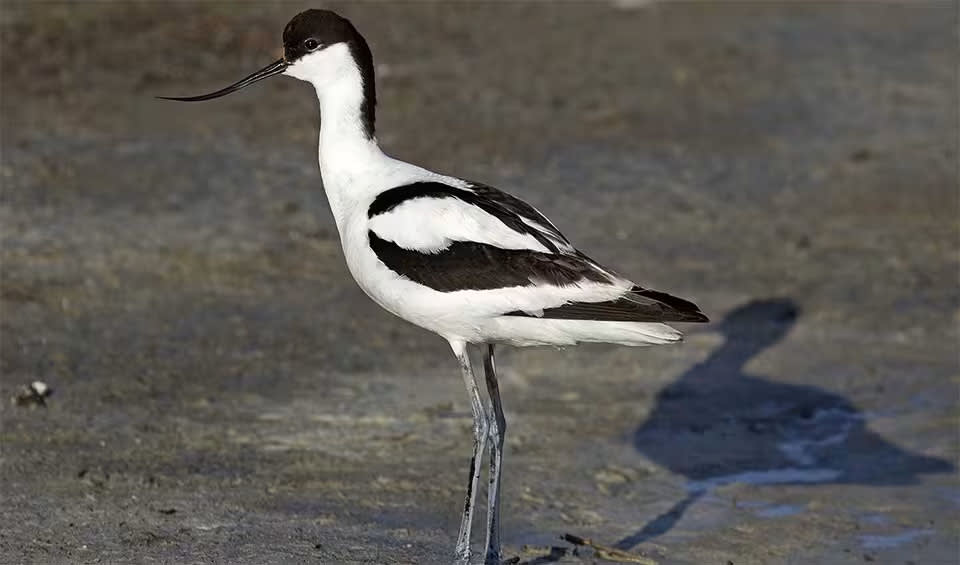A captivating species of wading bird native to the Old World. Characterized by its striking black and white plumage and its distinctive upturned, slender beak, the Pied Avocet cuts a graceful figure as it forages along the shores of wetlands and estuaries.
Both male and female Pied Avocets sport similar plumage adorned with bold contrasting colors of black and white. However, keen observers may note subtle differences, such as the slightly shorter and more curved beak of the female compared to the male. These avian beauties are renowned for their elegant appearance and their graceful movements as they wade through shallow waters in search of prey.
The preferred habitats of the Pied Avocet vary throughout its range, but they typically favor flat, open environments with brackish or salty waters and sparse vegetation for breeding purposes. Breeding colonies are commonly found in locations such as lakes, lagoons, saltpans, and estuaries where suitable nesting sites and food resources are abundant. During the breeding season, these birds meticulously construct nests on the ground, often lining them with twigs, grasses, and other natural materials.
Outside of the breeding season, Pied Avocets may frequent muddy tidal flats, where they use their specialized bills to probe the substrate for invertebrates, crustaceans, and small fish. While they primarily inhabit coastal areas, they may occasionally venture into freshwater habitats such as lakes and rivers, particularly during migration or in search of suitable foraging grounds.
Distribution
 Afghanistan
Afghanistan Albania
Albania Algeria
Algeria Angola
Angola Armenia
Armenia Austria
Austria Azerbaijan
Azerbaijan Bahrain
Bahrain Bangladesh
Bangladesh Belgium
Belgium Benin
Benin Bhutan
Bhutan Botswana
Botswana Bulgaria
Bulgaria Burkina Faso
Burkina Faso Burundi
Burundi Cameroon
Cameroon Central Af. Rep.
Central Af. Rep. Chad
Chad China
China Croatia
Croatia Cyprus
Cyprus Czechia
Czechia DR Congo (Kinshasa)
DR Congo (Kinshasa) Denmark
Denmark Djibouti
Djibouti Egypt
Egypt Eritrea
Eritrea Estonia
Estonia Eswatini
Eswatini Ethiopia
Ethiopia Faroe Islands
Faroe Islands Finland
Finland France
France Gambia
Gambia Georgia
Georgia Germany
Germany Gibraltar
Gibraltar Greece
Greece Guinea-Bissau
Guinea-Bissau Guinea
Guinea Hungary
Hungary Iceland
Iceland India
India Iran
Iran Iraq
Iraq Israel
Israel Italy
Italy Jordan
Jordan Kazakhstan
Kazakhstan Kenya
Kenya Kuwait
Kuwait Kyrgyzstan
Kyrgyzstan Latvia
Latvia Lebanon
Lebanon Lesotho
Lesotho Liberia
Liberia Libya
Libya Luxembourg
Luxembourg Madagascar
Madagascar Malawi
Malawi Mali
Mali Mauritania
Mauritania Moldova
Moldova Mongolia
Mongolia Montenegro
Montenegro Morocco
Morocco Mozambique
Mozambique Myanmar
Myanmar Namibia
Namibia Netherlands
Netherlands Niger
Niger Nigeria
Nigeria North Macedonia
North Macedonia Norway
Norway Oman
Oman Pakistan
Pakistan Poland
Poland Portugal
Portugal Qatar
Qatar Romania
Romania Russia
Russia Rwanda
Rwanda Saudi Arabia
Saudi Arabia Senegal
Senegal Serbia
Serbia Sierra Leone
Sierra Leone Slovakia
Slovakia Slovenia
Slovenia Somalia
Somalia South Africa
South Africa South Sudan
South Sudan Spain
Spain Sri Lanka
Sri Lanka Sudan
Sudan Sweden
Sweden Switzerland
Switzerland Syria
Syria Tajikistan
Tajikistan Tanzania
Tanzania Tunisia
Tunisia Turkey
Turkey Turkmenistan
Turkmenistan Official estimate
Official estimate
 UAE
UAE Uganda
Uganda Ukraine
Ukraine United Kingdom
United Kingdom Uzbekistan
Uzbekistan Yemen
Yemen Zambia
Zambia Zimbabwe
ZimbabweAnything we've missed?
Help us improve this page by suggesting edits. Glory never dies!
Suggest an editGet to know me
Terrestrial / Aquatic
Altricial / Precocial
Polygamous / Monogamous
Dimorphic / Monomorphic (size)
Active: Diurnal / Nocturnal
Social behavior: Solitary / Pack / Herd / Flock
Diet: Carnivore / Herbivore / Omnivore / Piscivorous / Insectivore
Migratory: Yes / No
Domesticated: Yes / No
Dangerous: Yes / No




